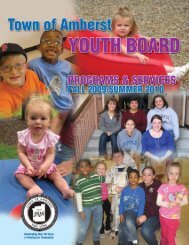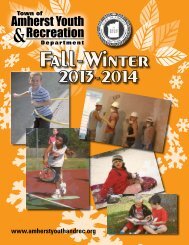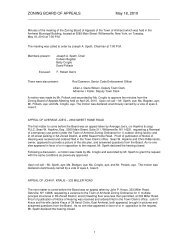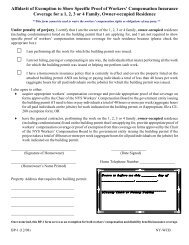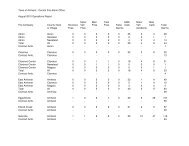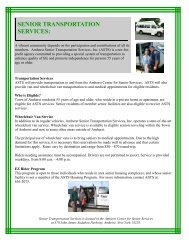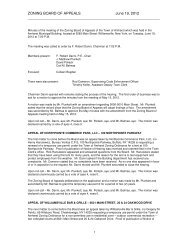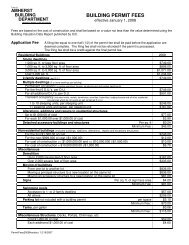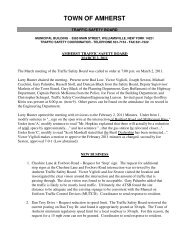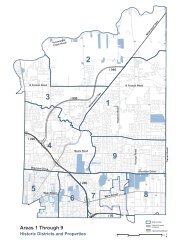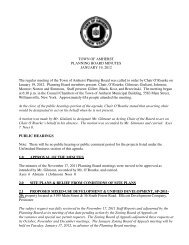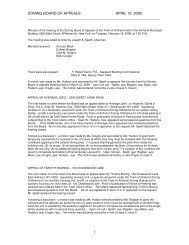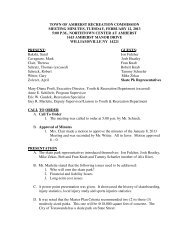3.0 Land Use and Development - Town of Amherst
3.0 Land Use and Development - Town of Amherst
3.0 Land Use and Development - Town of Amherst
You also want an ePaper? Increase the reach of your titles
YUMPU automatically turns print PDFs into web optimized ePapers that Google loves.
TOWN OF AMHERST BICENTENNIAL COMPREHENSIVE PLAN<br />
bonuses, smaller lot sizes, narrow street widths to<br />
promote pedestrian scale) <strong>and</strong> clearer, more “userfriendly”<br />
regulations <strong>and</strong> approval processes.<br />
• Establishing clear development st<strong>and</strong>ards tied to<br />
Comprehensive Plan objectives. These st<strong>and</strong>ards can<br />
draw upon principles <strong>of</strong> compact, efficient development<br />
such as neo-traditional design. Also referred to as<br />
traditional neighborhood development (TND), neotraditional<br />
design is emerging nationally as an alternative<br />
to single-use, automobile-oriented subdivisions. Based<br />
upon characteristics predominant in pre-World War II<br />
communities, typical features <strong>of</strong> TND design include:<br />
− Interconnected, pedestrian-oriented street systems<br />
− Places to shop <strong>and</strong> work <strong>and</strong> public/institutional uses<br />
such as a school, park, or church within walking<br />
distance <strong>of</strong> residences, typically in neighborhood<br />
centers<br />
− Coordination with transit service<br />
This concept is not a new one to <strong>Amherst</strong>. Older<br />
neighborhoods such as Eggertsville <strong>and</strong> Snyder<br />
demonstrate many characteristics <strong>of</strong> TND design <strong>and</strong> can<br />
be drawn upon as models in developing the st<strong>and</strong>ards.<br />
Traditional residential<br />
neighborhood development.<br />
Source: www.pedbikeimages.org<br />
• Better defining locations appropriate for application<br />
<strong>of</strong> Planned Residential options. With a minimum size<br />
limit <strong>of</strong> 50 acres, the current PRD option is oriented<br />
towards “greenfield” development on larger sites <strong>and</strong><br />
thus is primarily applicable to northern <strong>Amherst</strong>. This<br />
size limit must be reevaluated <strong>and</strong> st<strong>and</strong>ards defined for<br />
application to infill <strong>and</strong> redevelopment sites in developed<br />
contexts. In addition, application <strong>of</strong> mixed-use options<br />
should be coordinated with mixed-use activity centers<br />
defined per Policy 3-1.<br />
3-3 Modify provisions <strong>of</strong> the Suburban Agricultural District<br />
to reduce conversions <strong>of</strong> rural to suburban development<br />
patterns.<br />
The <strong>Town</strong>’s lowest density residential zoning district at one<br />
unit per acre, the Suburban Agricultural (S-A) District has<br />
traditionally functioned as a “holding zone” for rezoning to<br />
more intense residential <strong>and</strong> other uses. This trend has created<br />
uncertainty <strong>and</strong> contributed to the gradual erosion <strong>of</strong> the<br />
<strong>Town</strong>’s rural character. The Conceptual <strong>L<strong>and</strong></strong> <strong>Use</strong> Plan shows<br />
certain areas in northern <strong>Amherst</strong> to remain in agricultural<br />
<strong>and</strong> rural uses. An agricultural zoning district should be<br />
created <strong>and</strong> applied to areas that are farmed or are designated<br />
as part <strong>of</strong> the <strong>Town</strong>’s Farml<strong>and</strong> Protection Program. To<br />
regulate residential development outside <strong>of</strong> these areas, a new<br />
zoning district (possibly renamed Rural Residential to more<br />
clearly identify the intent <strong>of</strong> the district) should be created<br />
with provisions added to promote rural development patterns.<br />
3-6<br />
<strong>Town</strong> Board Adopted Plan (Amended March 2009) – <strong>L<strong>and</strong></strong> <strong>Use</strong> <strong>and</strong> <strong>Development</strong>



